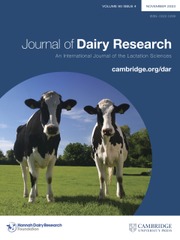No CrossRef data available.
Article contents
Insights into epidemiology, molecular characterization and antibiogram profiling of biofilm-forming Staphylococcus aureus isolated from goat mastitis
Published online by Cambridge University Press: 27 October 2025
Abstract
This study was undertaken to investigate the molecular detection of biofilm-producing Staphylococcus aureus (S. aureus) from goat mastitis. An overall 384 milk samples were initially screened for subclinical mastitis (SCM) followed by molecular characterization of S. aureus isolates. The biofilm formation was assessed using Congo Red agar (CRA), a microtiter plate and the presence of the icaA gene. The results revealed a molecular prevalence of 53.24% (115/216) for pathogenic S. aureus in milk samples of goats. The phenotypic prevalence of biofilm production by CRA and microtitre methods was recorded to be 38.26% (44/115) and 26.96% (31/115) respectively, while the molecularly confirmed biofilm-forming S. aureus through polymerase chain reaction targeting icaA gene was 58.26% (67/115). The phylogenetic analysis of icaA gene revealed high identity between sequences of study isolates and the isolates of other neighbouring countries. The antibiogram profiling of pathogenic S. aureus showed increased resistance to cefoxitin and oxytetracycline followed by gentamicin. Out of 115, 45.22% (52/115) were declared as multiple drug resistant with multiple antibiotic resistance index greater than 0.2. The study concluded that biofilm-producing S. aureus strains are considered to be a common cause of SCM in dairy goats of Pakistan and biofilm formation is associated with multidrug resistance of study isolates.
Information
- Type
- Research Communication
- Information
- Copyright
- © The Author(s), 2025. Published by Cambridge University Press on behalf of Hannah Dairy Research Foundation.

